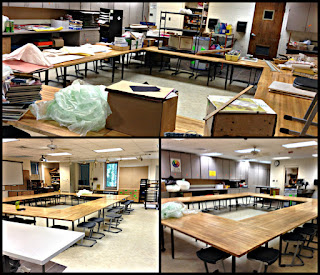During my my last internship, I was placed at a high school for one semester and the teacher had two large connected classrooms giving him about 2,000 square feet easy. It was difficult to adjust to the room, because it was poorly laid out. There were unorganized supplies in random closets, brand new supplies mixed with old, rarely if ever used supplies, there were speed bumps that interrupted traffic flow, and the storage of student work was often difficult. I would often go in for several hours on the weekend to finish grading and to just sit and imagine how I would change the room to make it more efficient and conducive to making art. This process of focusing on foot traffic, grouping supplies, and re-imagining storage gave me the skills I needed to be a successful art teacher. I believe that the reason I've been successful has been because I have worked hard to lay a solid foundation with my room space. Having a room space that is well-grounded has helped me eliminate problems with transitions, material distribution, clean up, and student interaction. My room space is the first step I take when I come up with routines such as clean up or lining up too. Your room dictates the type of environment and energy your students will be making art in as well as how your routines will flow.
 |
| Panoramic view of my new room mostly setup. |
Sharing a room can also add to the difficulty of maximizing the space. The teacher or teachers you're sharing a room with all have a different teaching styles, different needs, and different supplies. My first teaching job was a .6 position just outside Detroit and I shared my room with the Mandarin teacher. She was a very nice woman, but the urban teaching environment was very difficult for her to manage and there were a lot of cultural misunderstandings too. Because she taught two classes in the morning, I taught three classes in the afternoon all of which were back to back, allowing us 5 minutes to change the room from a Mandarin classroom to an art room, we had a lot of problems. The second year I was teaching at this school I was given a room to myself, which allowed me to make it an art room and focus on the space I needed for efficient flow and creating a good work environment. My teaching subsequently improved because I wasn't fighting my layout.
 My second teaching location was in a K-4 elementary art room just outside of Grand Rapids. At this
My second teaching location was in a K-4 elementary art room just outside of Grand Rapids. At this school I was a .3 art teacher and shared the room with two other art teachers. It was nice to have an actual art room this time, but there were some difficulties in managing the space. After my day and a half of teaching was complete for the week, I had to tear down my expectations, artwork examples, and make sure my students had left supplies in the order they were found. It was a lot of extra work to put up and tear down your room in a matter of 48 hours. I really streamlined what I needed the students to see. One of the teachers I worked with was very organized and particular about how clean the room was and the other was much more messy and cumbersome with supplies. There were days I came to work only to find a mess left in the sink or all over the counter with the drying rack full which only added to my morning workload of preparation. Needless to say I survived, even when the construction paper package was partially opened (a huge pet peeve of mine), I survived and established my own routines with what I was given with my room layout. Teachers are great at making do with what they have.
Now I'm still in the same district but I moved buildings. I'm now a .7 art teacher in another K-4 elementary school and have my entire classroom to myself. It's a gorgeous room, with some large, gallery style track lighting on one wall, a large kiln room with ample cabinet storage, a paper storage room, and lots of cabinets. I do wish there was more flat storage built in but overall that is just a small problem that can eventually be fixed.
 |
| Random things found in the storage room. |
I'm still organizing and labeling things. Sometimes I catch myself grouping like items in one cabinet only to finish and then decide they need to be moved over one cabinet more. My room and I are still trying to figure one another out. My computer and teacher zone are a constant mess because of the way the technology requires my desk and I am still mulling over my student table arrangement decision. The more time I spend in my room, the more I am able to pinpoint what I need to fix. Which, when you've been in your classroom for 10 hours and every counter space is filled with paper and miscellaneous supplies, that overwhelming feeling creeps up on you and you can't focus beyond the need to get the basics taken care of.
 |
| The supply closets & Ben sorting paper. |
Overall, I've made it through twelve weeks of classes with everything rolling pretty smoothly. My room still has some areas that ail me but I keep looking for solutions. What I'm happy to announce is that I'm still keeping to my code even in my new, larger room, with vintage goodies. Layout is important and something I'm always questioning and reflecting on. I hope you enjoy some of my before and after photos of my room.
Happy dabbling.






















